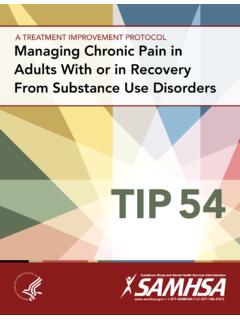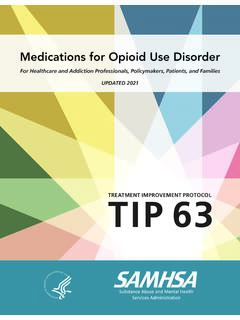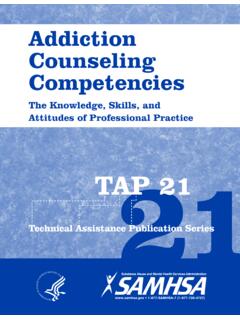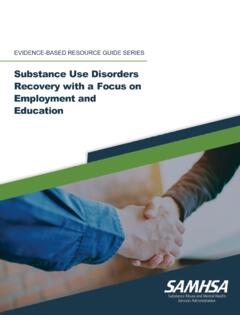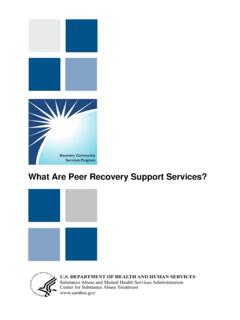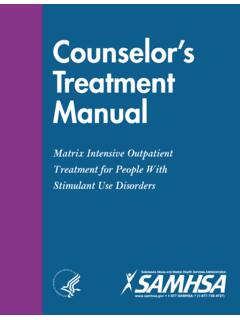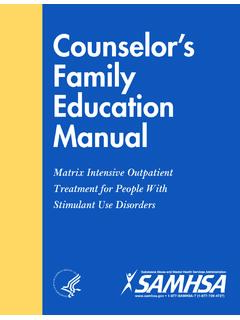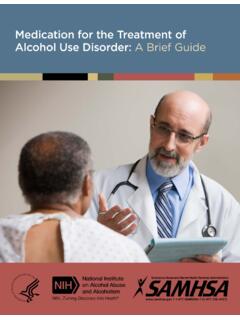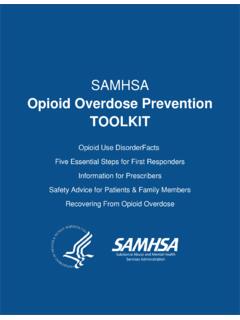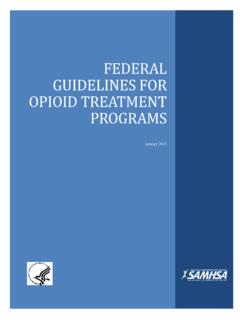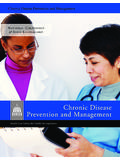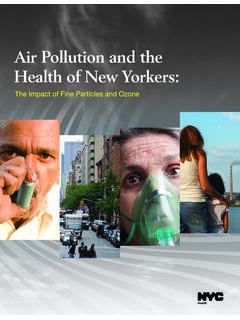Transcription of Behavioral Health Services for People Who are Homeless
1 Behavioral Health Services FOR People . WHO ARE Homeless . Introduction According to the Department of Housing and Urban Development's (HUD) 2020 Annual Homeless Assessment Report (AHAR) to Congress, on a single night in 2020, there were approximately 580,000 individuals experiencing homelessness in the United States. People experiencing unsheltered homelessness ( , those sleeping outside or in places not otherwise meant for human habitation) were typically concentrated in large cities, followed by suburban areas. Thirty percent of Homeless People were members of a family with at least one adult and one child under 18 years of age, and most Homeless People in families were sheltered.
2 Twenty-seven percent of those who were Homeless and residing in shelters were children under the age of 18, while percent of unsheltered People were aged 24 or older. Over 60 percent of all People experiencing homelessness in 2020 were males while African Americans comprised nearly four in 10 Homeless individuals, and 37,252 People experiencing homelessness were veterans (HUD, 2021). Ending homelessness is an important public Health issue in the United States. Many experiencing homelessness have high rates of chronic and co-occurring Health conditions, mental and substance use disorders. Individuals who are Homeless also may be dealing with trauma, and children experiencing homelessness are at risk for emotional and Behavioral problems (Perlman et al.)
3 , 2014). Additionally, research has shown that individuals who are Homeless have a risk of mortality that is to times greater than the general population (Gambatese et al., 2013). Preventive Services , including mental Health , substance use, medical care, and social supports, are needed for People who are Homeless , irrespective of whether they present with diagnosable conditions. According to data collected as part of the 2015 AHAR, over half of adults living in permanent supportive housing either had a mental disorder or co-occurring mental and substance use disorder (HUD, 2016). Further, People experiencing homelessness are at high risk of overdose from illicit drug use (SAMHSA, 2020).
4 To further compound these already significant problems, data show that adults aged 65 and older who are Homeless also have a higher prevalence of unmet needs for substance use and mental disorder treatment compared with their younger adult counterparts (Kaplan et al., 2019). Providing housing to People experiencing homelessness can help prevent the exacerbation of substance use and mental disorders; however, separate treatment and housing considerations must be accounted for when working with this population. 1. ADVISORY. This Advisory is based on SAMHSA's Treatment Improvement Protocol (TIP) 55, Behavioral Health Services for People Who Are Homeless .
5 It addresses the fundamentals of how providers and administrators can effectively employ approaches to address the complex challenge of providing comprehensive, integrated, and trauma-informed treatment Services to clients experiencing homelessness. Key Messages People who are Homeless are at elevated risk for experiencing substance use disorders (SUDs), mental disorders, trauma, medical conditions, employment challenges, and incarceration. People experiencing homelessness present unique treatment challenges, as both treatment and housing needs must be concurrently addressed for treatment to be most effective.
6 Preventive Services for People experiencing homelessness, including mental Health , substance use, medical care, and social supports, are critical for mitigating risks of SUDs and mental disorders and improving Health outcomes. Treatment providers must be knowledgeable about and help clients identify available housing resources. Person-centered prevention and trauma-informed treatment practices are essential when working with People experiencing homelessness and help prioritize and address the complex issues clients face. Providers should work with federal, state, and community-based agencies to secure permanent supportive housing placements for their clients.
7 Clinicians must know how to help individuals access federal or local benefits to improve housing stability. Defining Homelessness Homelessness exists on a continuum and is categorized in three ways (Burt, Aron, Lee, &. Valente, 2001; Gabrielova & Veleminsky, 2015): 1. Transitional homelessness: ranges from weeks to months, but less than a year, and includes People recently leaving prison or jail. 2. Episodic homelessness: refers to periods where individuals enter and leave homelessness repeatedly and is common among those with unstable housing situations. 3. chronic homelessness: refers to a period of homelessness lasting at least a year or occurring repeatedly while struggling with a disabling condition such as a serious mental illness (SMI), SUD, or physical disability (HUD, 2015).
8 2. SAMHSA'S mission is to reduce the impact of substance abuse and mental illness on America's communities. 1-877-SAMHSA-7 | (1-877-726-4727) 1-800-487-4889 (TDD) ADVISORY. Environmental and Individual Risk Factors for Homelessness Poverty and high housing costs that exclude individuals from the local housing market, the removal of institutional supports for individuals with SUDs, and decreased job options for individuals with only a high school education are just some of the environmental factors identified as contributing to homelessness (Burt, 2001; Tuller, 2019). Individual contributors that increase the likelihood of experiencing homelessness include: cognitive impairment, preexisting medical conditions, unemployment, and family instability (Giano et al.)
9 , 2020). Additionally, traumatic experiences early in life have been identified as a pathway into homelessness (Woodhall-Melnik et al., 2018). Of People who are Homeless and in substance use treatment, 68 percent of men and 76 percent of women reported experiencing a trauma-related event (Christensen et al., 2005; Jainchill et al., 2000). Cognitive impairment also increases the risk for homelessness. Up to 80 percent of People who are Homeless show some signs of cognitive impairment, which impacts their ability to learn new skills (Spence, Stevens, & Parks, 2004). Co-occurring medical conditions like HIV/.
10 AIDS, hepatitis B and C, cardiovascular conditions, dental problems, asthma, diabetes, and other medical problems are more prevalent among People who are Homeless and individuals with SUDs compared to those who are housed (Fazel et al., 2014; Noska et al., 2017; Bagget et al., 2018;. Kolla et al., 2020; Mejia-Lancheros et al., 2020). Preventive Services for People Who Are Homeless Preventive Services may include medical care, housing support, and other social and supportive Services ( , employment, educational supports for children). These Services help a client work toward housing stability and support retention in substance use and mental Health treatment and long-term recovery.
